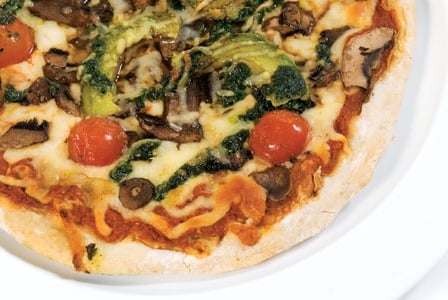
Frozen food has come a long way since Swanson first introduced its meal-in-a-box in the 1950s.
Frozen food has come a long way since Swanson first introduced its meal-in-a-box in the 1950s. Bland options such as rubberized turkey and chalky mashed potatoes have given way to hipper tandoori chicken and butternut squash ravioli. Sure they’re quick, convenient, and now actually tasty, but are they healthy?
Thankfully, good-for-you frozen dinners, pizzas, and lasagna are finding more grocery store freezer space and may even offer a nutritious option when the daily grind leaves little room for home cooking.
What’s more, researchers at the University of Illinois found that packaged meals may help speed weight loss through better portion control. It could be the coolest diet ever.
But make the wrong choices, and you’ll be filling your belly with as many nutritional villains—such as sodium and saturated fat—as a Happy Meal. To make sure that you don’t sacrifice your health (and your midriff) for convenience, here’s how to select the frozen food that’s best for you.
Great grains
Along with improving heart health, Pennsylvania researchers recently found that subjects who consumed more whole grains lost twice as much abdominal fat as subjects who noshed mostly on refined (white) grains. The researchers credit fibre and antioxidants in whole grains for the weight-loss impact.
Thankfully, an increasing number of frozen meals are sneaking in healthy grains such as brown rice. Even whole grain frozen pizza crust is no longer as hard to find as it once was.
Fat that’s not PHAT
Ideally you’ll want to choose items that have kept a lid on saturated fat at around 4 g or less. Even more important, there should be no trans fat (partially hydrogenated oil), as this is an even bigger health hazard.
When it comes to fat, look for the healthy monounsaturated and polyunsaturated types that can come from nuts and unbattered fish.
Thanks to several forward-thinking food companies, the amounts of saturated and trans fats found under the plastic covering have been shrinking faster than an over-nuked broccoli floret.
Salt lick
It’s not hard to find a frozen meal with salt on par with the Atlantic Ocean, as food manufacturers often give the salt shaker a stiff workout. To put an end to a freezer full of salt licks, it’s best to hunt down products with a sodium level that does not exceed 600 mg. Walk right past those that’ll raise your blood pressure one bite at a time.
Protein power
Because protein is often the most expensive ingredient, some brands will add fewer items such as chicken and fish and instead fill the container with cheaper foods such as white rice and mashed potatoes.
A well-rounded frozen meal will have roughly 12 to 15 g of protein which, in addition to helping to build lean body mass, will make the meal more filling. Tofu and beans are two good protein sources to look for in frozen meals.
Roughing it
It’s not surprising that a frozen meal loaded with refined grains, mystery sauce, Salisbury (mis-)steak, and gooey cheese at the expense of whole grains and veggies is going to be light in fibre.
A smart choice will have 3 g of fibre or more per serving. If there are plenty of vegetables, beans, and whole grains, this should not be a difficult level to achieve. In addition to fibre’s heart and digestive benefits, a frozen meal with more fibre will help temper appetite, making it less likely you’ll dig into the ice-cream tub afterward.
Sweet stuff
Desserts and sauces can really bump up the sweetness, which can send your blood sugar on a rocky Mountain high. It’s best to cap sugar at 10 g.
Counting calories
Frozen dinners should contain at least 250 calories. After all, this is supposed to resemble a meal, not a glorified snack that will have you banging on the fridge door in no time.
Planet friendly
Mama Earth will be so proud if you opt for convenience meals that are made with organically grown ingredients.
Make it better
Yummy up your heat-and-eat meals with these smart additions that will turn the meals into nutritional stars.
Vegetables
Despite improvements, it’s hard to count on a frozen meal to make a big impact on your daily vegetable quota. Besides, the veggies are often as fresh as an MC Hammer album. It takes little time to chop up tomatoes, broccoli, or spinach and add these to the mix. Or keep a bag of frozen vegetables on hand and use these to add more hues to your meal.
Spices
Jazz up even the most ho-hum meal-in-a-box with a sprinkle of turmeric, chili pepper, cumin, or other spices. Along with the flavour perks, most spices are potent sources of disease-fighting compounds. Chopped fresh ginger can also add some wow! factor.
Protein
Without any cooking required, frozen meals can instantly become protein powerhouses. Try tossing canned beans or precooked shrimp into pasta dishes. Smoked salmon shines on frozen pizza, while ordinary lasagna is shouting out for a dollop or two of low-fat cottage or ricotta cheese.
Healthy fat
Boosting heart-healthy fats is as easy as a drizzle of olive oil, a handful of seeds such as sesame and sunflower, or a sprinkle of ground flaxseed.
Fresh versus frozen
There’s no need to be a fresh-food snob. Vegetables and fruit are often fl ash frozen at the peak of freshness and ripeness. ergo, they can contain more nutrients than fresh versions that have travelled long distances, let alone left to sit in your fridge for a week.
Matthew Kadey, MSc, RD

